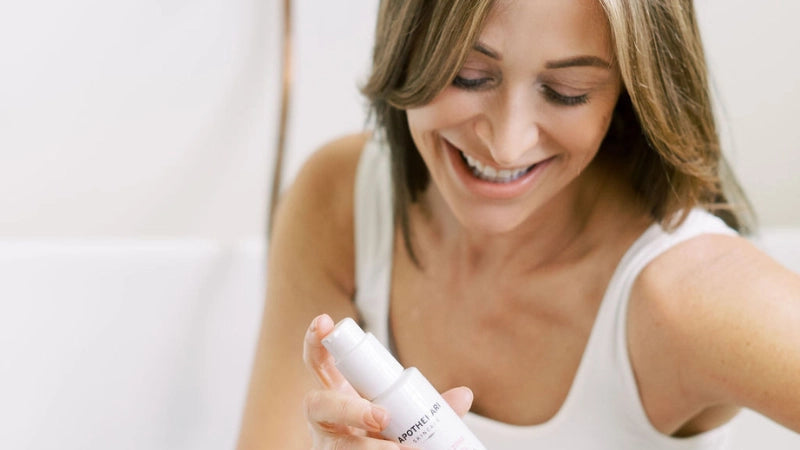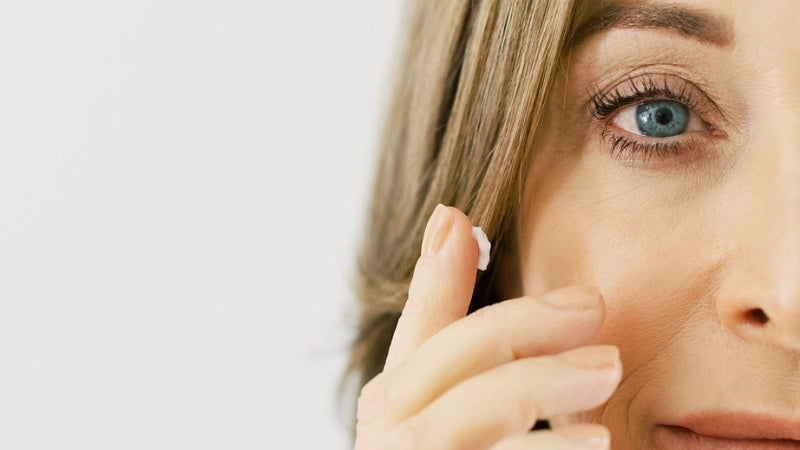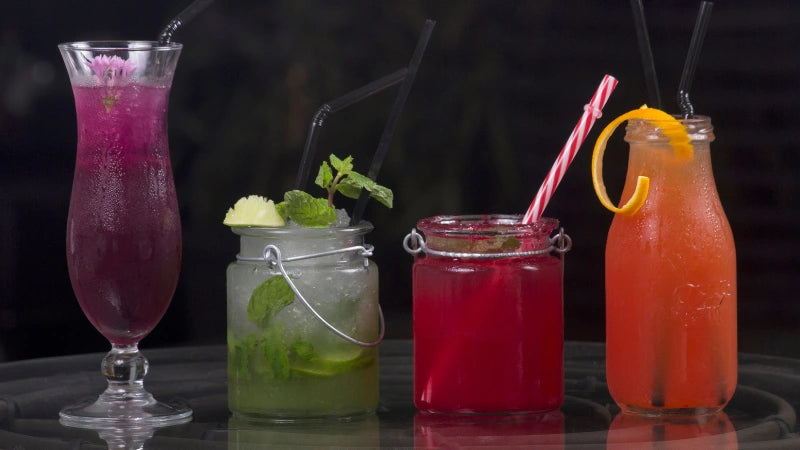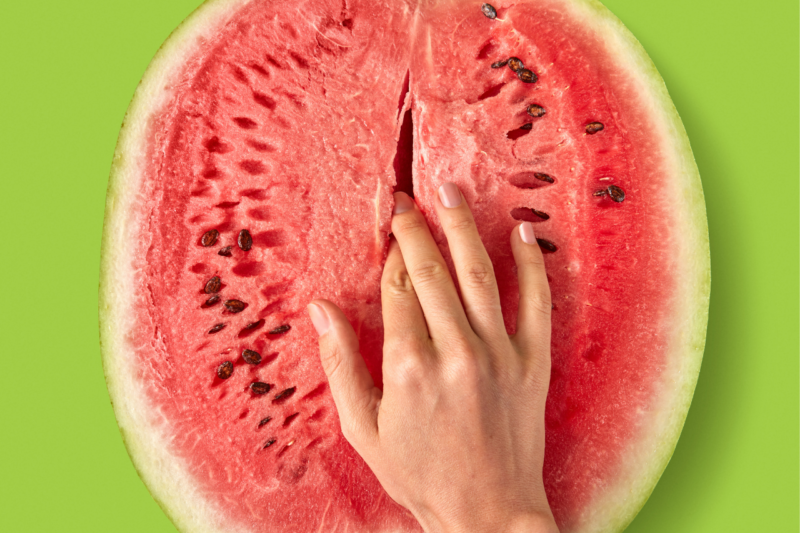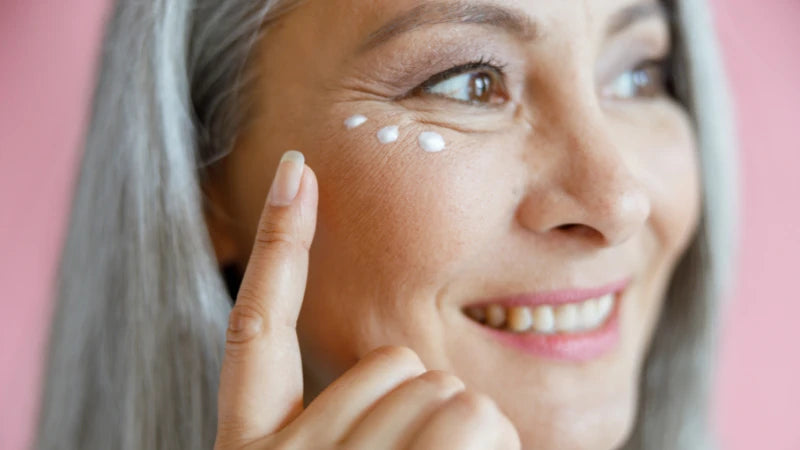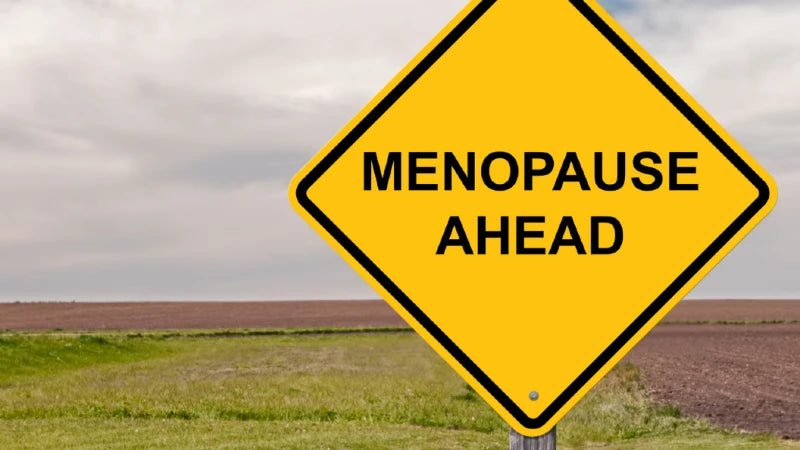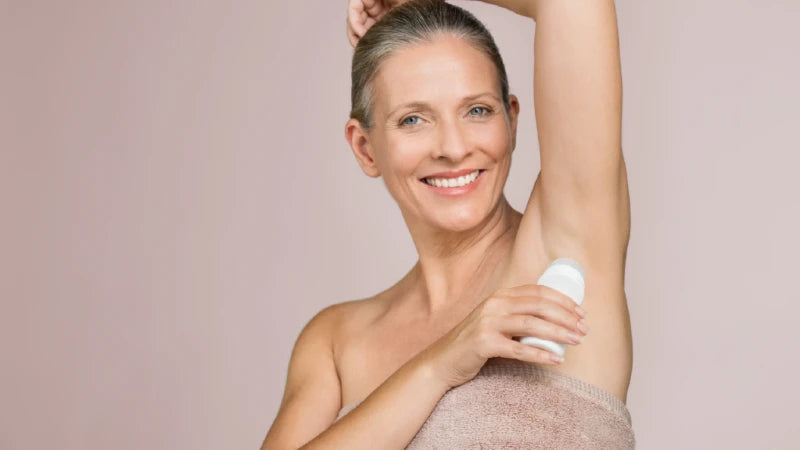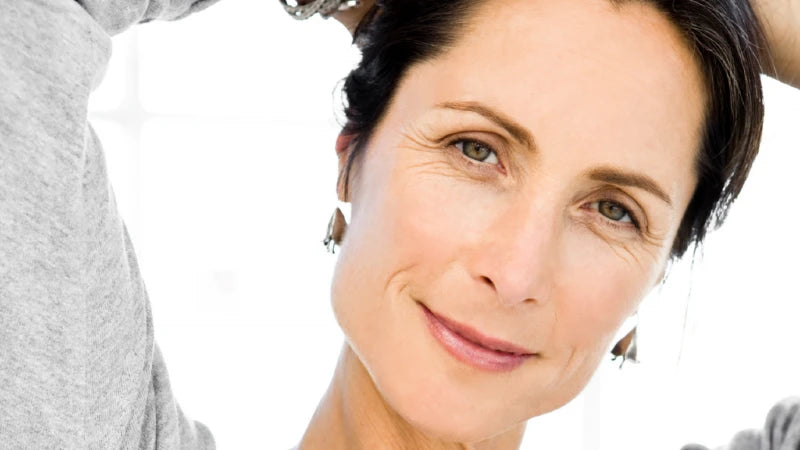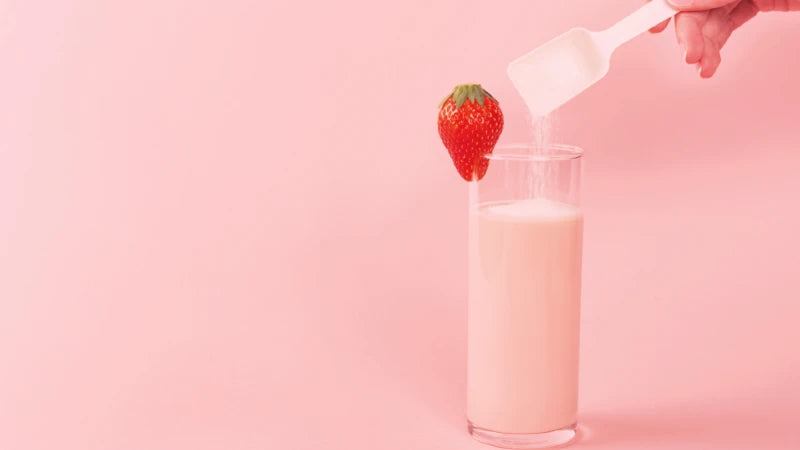Blog
Skincare is Self Care. Make it a Ritual.
Skincare is selfcare? It’s an often cited mantra that we hear these days. Yet in the hustle and bustle of our daily lives, when we’re trying to juggle so many different things, it’s easy to overlook the significance of our skincare routine. Shop All Apothekari But what if I told you that your skincare regimen is more than just a series of steps to maintain healthy skin? It’s also a self-care ritual—an act of kindness you show to yourself daily. Your skin, the body’s largest organ, deserves attention beyond the superficial, and this attention can manifest as a deeply enriching experience. Your skincare routine should be more than a task; it should be something you genuinely enjoy. Consider it an opportunity to engage in a ritual that provides benefits not only to your skin but also to your mind and overall well-being. The importance of establishing routines lies in the sense of predictability they bring. As your skincare routine becomes a consistent part of your day, it transforms into a source of comfort, a predictable retreat in an otherwise chaotic world. Picture this: you’re in your bathroom, perhaps with your favorite calming playlist in the background. The gentle application of skincare products becomes a form of self-love, a few moments dedicated entirely to yourself. It’s an almost meditative experience, a pause in the daily hustle to reconnect with your body and send a powerful message that you matter. Elevate Your Skincare Practice with These Tips Now, let’s infuse some magic into your skincare routine with these tips to turn it into a full-fledged self-care celebration: Set the Mood with Relaxing Music. Transform your skincare space into a personal sanctuary by playing your favorite tunes. Let the soothing sounds create a spa-like ambiance. Meditate Your Way to Glowing Skin. Elevate your routine with a guided meditation app. Combine the benefits of skincare with the tranquility of meditation for a truly holistic experience. Indulge in a Luxurious Bath. Take your self-care routine up a notch by indulging in a long bath, scrubbing away roughness with our Foaming Bamboo Polish, followed by our Shea Body Butter. It’s a sensory delight that locks in moisture and leaves you feeling pampered. Enjoy the Art of Skincare. Embrace the simple steps, like massaging a serum or our Antioxidant Face Oil into your skin. These moments of self-massage not only benefit your skin but are also incredibly relaxing for your mind and body. 7 Science-Backed Self-Care Ideas For You to Embrace I’m not messing around, cause these are seven science-backed self-care ideas that can seamlessly integrate into your daily, weekly, or even hourly schedule. The good news? They’ll not only help you to feel better–and when you feel better, you’ll look better too: Get Outside. Step into nature to reap its meditative benefits while also incorporating some exercise into your routine. Pay it Forward. Spread joy by helping others, whether it’s through giving your time, money, or a heartfelt compliment. The positive energy you share will, in turn, uplift your spirits. Stress Less. While stress is inevitable, find strategies to manage it. Whether it’s a brief tea break or some alone time, these moments contribute to your overall well-being. Be Mindful. Practice being present, steering clear of worries about the past or anxieties about the future. Mindfulness can significantly enhance your mental health. Dance. Burn calories and boost your mood with a spontaneous dance party—perhaps even while prepping dinner. It’s a fun and effective way to stay active. Eat More Fruits and Veggies. Fuel your body with a rainbow of nutrient-rich foods, providing antioxidants, micronutrients, and fiber essential for good health. Get Enough Zzzs. Prioritize sleep, even if it’s just a quick cat nap. Quality sleep is linked to a myriad of health benefits, from improved mood to reduced risk of chronic conditions. Is Skincare a Form of Self-Love? Absolutely! Your skincare routine is a daily affirmation of self-love, a consistent practice that highlights your importance amidst life’s chaos. Why is Skincare Important to Life? Skincare transcends mere aesthetics; it’s a form of self-nurturing that sends a powerful message to your body: you value and care for it. Can Skincare Boost Self-Esteem? Indeed. A thoughtful skincare routine can boost self-esteem by fostering a positive self-image and instilling a sense of self-worth. Is Skincare Part of Your Lifestyle? If it isn’t it absolutely should be! Integrating skincare into your daily routine enhances your lifestyle, creating pockets of self-indulgence and care throughout your day. Benefits of Skincare on Mental Health Beyond its physical effects, skincare has an impact on mental health, offering moments of tranquility and self-reflection. Your skincare ritual becomes a daily dose of mindfulness, contributing to a healthier state of mind. As you embark on this journey of skincare as self-care, remember: it’s not just about looking good; it’s about feeling good, embracing moments of tranquility, and sending a powerful message to yourself that you are worthy of love, care, and radiant skin. Your skincare ritual is your daily celebration of self, a small yet significant act that contributes to your overall well-being. So, let the magic of skincare and self-care unfold each day, making you feel as beautiful on the inside as you look on the outside. Cheers to a healthier, happier you!
Learn moreHow To Look After Your Aging Skin: A Pharmacist's Guide to Skincare After 50
If you’re seeking the inside scoop on aging skin care, step into the laboratory of skincare wisdom. Our founder, Sharmani, a pharmacist and a mature woman herself, expertly blends science with style to unveil the art of aging gracefully. Ready for a journey that’s as scientific as it is fabulous? Shop Active Treatment Serums Is 45 Too Late to Start A Skincare Routine? It’s never too late! Dive into the world of timeless beauty with three main products, the Holy Grail for mature skin: Sunscreen Vitamin C (like the triple combination of vitamin C and antioxidants found in our Glow Getter3 Serum) Retinoids, like the powerful, yet gentle retinaldehyde combined with other highly active ingredients in our Advanced+ Renewal Serum. These three products should form the foundation for your aging skin care regimen. What Should My Skincare Routine Be at 50? Whether you started earlier or are just embarking on your serious skincare journey at 50, there’s no wrong time to craft a precise skincare routine. The same principles apply to 50-something skin as it does in your 40s: sunscreen, vitamin C, and retinoids. And because 50-something skin can start to experience dryness, make sure you have a good moisturizer like our Daily Infusion+ on hand. This hydrating powerhouse keeps your skin’s balance in check. How Can I Make My Aging Skin Look Better? To minimize the appearance of wrinkles and fine lines and leave your skin looking radiant and glowing, elevate your skincare routine with our Radiant Skin Set, which combines a morning and nighttime serum (Glow Getter3 and Advanced+ Renewal) for radiant and youthful-looking mature skin. Make sure to use something to combat dryness, which can age skin. Should You Use Retinol in Your 50s? Absolutely, let science lead the way! Retinoids are backed by oodles of evidence to show that they stimulate collagen production, bidding farewell to fine lines and wrinkles. They also increase skin cell turnover, fight hyperpigmentation, and even increase your skin’s moisture content, helping to combat dryness. Think of retinoids as your skin’s secret weapon, deployed under the cover of night. (retinoids should be applied at night because they are sensitive to sunlight and prone to degradation when exposed to UV rays.) We’re huge fans of the benefits that come with retinaldehyde, found in our Advanced+ Renewal Serum. What is the Best Skin Care Routine for Women Over 50? For actual results (not overhyped nonsense), get started with our Ageless Skin Set. In addition to our two serums, Glow Getter3 and Advanced+ Renewal, we include our hydrating Daily Infusion+ Moisturizer and Amazing Clean, an exfoliating cleanser (but caution sensitive skin with this one!) It contains the essentials for better looking skin–just add sunscreen. What is a Good Skin Care Routine for Aging Skin? Crafting a good skincare routine for mature skin isn’t as difficult or as confusing as you may imagine. Start with cleansing, which helps remove dirt and make-up and provides a clean canvas to help absorb other products. Next, prevent damage and protect skin with antioxidants and sunscreen. Finally, add in a retinoid treatment to rejuvenate and perfect skin. Nourishing face oils like our Antioxidant Face Oil and performance moisturizers like our Daily Infusion+ Moisturizer help keep mature skin protected against dryness, which can emphasize the appearance of wrinkles and fine lines. What is the Best Treatment for Aging Skin? The ultimate treatment for mature skin? It’s about finding the right products that work for YOUR skin and using them consistently. Beautiful skin doesn’t happen overnight or by chance. It’s a combination of a number of factors, including your lifestyle, your genetics and the skincare products you use. Eat well, exercise, get enough sleep, manage stress. Then add in scientifically proven ingredients and use them consistently in your skincare routine. Find products and a program that works for you and stick with it. It can take weeks to months to notice a difference. But stay with it, and you’ll reap the benefits. Dos and Don’ts For Skincare After 50 Now, let’s dive into the two most important Dos and Don’ts for skincare after 50. ✅ Do embrace a consistent routine tailored to your skin’s needs. ❌ Don’t skip sunscreen; it’s your best defense against premature aging. Should You Use Anti-Aging Products? Let’s challenge the term “anti-aging.” At Apothekari, we believe in embracing the beauty of getting older. Anti-aging suggests a fight against the natural process of aging, while we encourage a celebration of the journey and caring for your skin gracefully. We’ve long dropped this term from our marketing and we think it’s high time that everyone else does too! How to Care for Oily Mature Skin If you’re dealing with oily aging skin, embrace balance. Cleanse with our Amazing Clean, designed for exfoliation without irritating. Use lightweight moisturizers like our Daily Infusion+ to hydrate without causing excess oil. Retinoids like the retinaldehyde found in our Advanced+ Renewal Serum have been shown to minimize the appearance of blemishes and breakouts due to their impact on managing oil production and antibacterial effects. If you find yourself starting to breakout like you did in your teens, Advanced+ Renewal may just save the day! How Can I Make My Aging Skin Look Better? We really don’t think there’s a better place to start seeing a transformation in your mature skin than by elevating your routine with our Radiant Skin Set. This duo of serums (Glow Getter3 and Advanced+ Renewal) works in harmony for radiant, youthful-looking skin. As you gracefully move through your 60s and 70s, continue with the same Apothekari products that are working for you. There’s no need to change things up because your skin doesn’t become immune to the effects of a good skin care product. If you notice that your skin becomes drier or more sensitive, look for moisturizers that deliver heavy-duty results. Or consider adding in a face oil. You may also notice dryness in areas besides your face. It’s one of the reasons that we developed More Than Lip Service. This vulvar and vaginal moisturizer delivers fast, long-lasting, and hormone-free relief from the pain, burning, and irritation that many women experience down there as they get older. Explore how our range adapts to the evolving needs of your skin, ensuring a radiant and healthy complexion. Here’s to timeless elegance, no matter your age.
Learn moreDry January: Are You Missing Out?
Welcome to that time of the year when wine glasses take a back seat, and water bottles step into the spotlight. For me, it’s the seventh spin on the Dry January train—a tradition that started with a classic hub-side eye-roll, questioning my sanity. Little did he know; he secretly looks forward to it every year. Or maybe he’s just a really good actor! What’s the Buzz with Dry January? So, why Dry January, you ask? Well, it’s my post-holiday ‘cleanse’—and I use the term loosely. After a month of indulging in festive foods and perhaps a tad too much wine, January becomes my month of redemption. Out go the cheese, wine and shortbread cookies; in come veggies and water. It’s all in an attempt to squeeze into my favorite jeans without having to go up a size. Because, let’s face it, my wardrobe and I are inseparable BFFs, and I’m not about to betray it. (and yes, there’s the undeniable benefit of just feeling better nourishing my body with healthier options) The Dry January Elevator Pitch Abstaining from alcohol is the easy part. Explaining it? Now, that’s the real challenge. “No, I’m not pregnant. It’s just a miracle I’m still standing at my age!” It took a while, but I’ve perfected my Dry January elevator pitch over the years. What is the Point of Dry January? Dry January isn’t just about swapping out alcoholic beverages for non-alcoholic delights. For me, it’s a personal reset button, a chance to recalibrate after the holiday frenzy. It’s an opportunity to focus on nourishing my body with veggies and hydrating with water, all while giving my skin the love it deserves. Why Do They Call it Dry January? The name might sound straightforward, but the origins of Dry January are rooted in mindfulness. It started in the UK as a movement to encourage people to be more conscious of their alcohol consumption after the indulgent holiday season. The trend has since spread globally, with many embracing the challenge as a way to kickstart a healthier year. What are the Rules for Dry January? The rules are simple: no alcohol for the entire month of January. It’s a commitment to sobriety for 31 days, allowing your body to reset. It’s not about perfection but about the intention to break the habit of regular alcohol consumption. (and goodness knows, we’ve read enough articles lately about the negative impact of excessive alcohol consumption on our wellbeing). Dry January Benefits Aside from the obvious health benefits like improved liver function and better sleep, Dry January can do wonders for your skin. Alcohol can dehydrate the skin, leading to dullness and premature aging. Dry January Skin Benefits Beyond the general health perks, the impact on your skin can be quite noticeable. One of the key benefits is the restoration of skin hydration. Alcohol is very dehydrating and as a result, notorious for drying out the skin. This often causes dullness and the acceleration of premature aging. By abstaining from alcohol, you’re allowing your skin to reclaim its moisture, leading to a radiant and healthier complexion. What are the Disadvantages of Dry January? While the advantages outweigh the disadvantages, some may find social situations challenging without the usual social lubricant. However, navigating these situations sober can lead to personal growth, increased confidence, and a deeper connection with others. You’ll never know unless you try it! My Dry January Sippers Just because I’ve gone alcohol free, it doesn’t mean I don’t want something special to sip on. Thankfully, we’re pretty spoiled for choice when it comes to prepared mocktails, zero proof beers and even some wine–but there’s still a way to go in that department. Besides the standard bubbly water and Coke Zero in our fridge, I’m currently savoring Sober Carpenter’s incredible IPA. I’ve also delved into the world of Clever Mocktails—a collection of delectable, not overly sweet concoctions. (Check out their G and T or Mojito). Unfortunately–and sadly–because I love red wine, I think they still have a way to go before one will pierce my Dry January heart. I have had luck with some sparkling wines made by Noughty and Oddbird have left a pleasant impression. I think sparkling is definitely the way to go here! And, of course, my inner mixologist makes an appearance in my spare time—blame it on the pharmacist in me! For the behind-the-scenes magic, check out my Instagram where I will be sharing any concoctions I come up with. And, check out our last post, where I shared the recipes for 3 mocktails that you may want to try making yourself. Now I know that Dry January isn’t for everyone. And if that’s the case, there’s no judgement here—you do you! But, if you decide to participate, you may be pleasantly surprised by how you feel after a month without alcohol. Got any stories to share? We’re all ears!
Learn more3 Mocktails to Help You Celebrate the Season
Ready for a journey into the world of mocktails? Fantastic! Grab your favorite mug because we’re about to dive into the ultimate guide to mocktails—a celebration of flavor, wellness, and pure joy. Why Choose Mocktails Over an Alcoholic Drink? In a world where choices abound, we’ve got you covered with recipes for 3 mocktails that you can indulge with this season. Let’s explore the perks, from maintaining a clear head to being the life of the party without the morning-after regrets. Say goodbye to hangovers and hello to vibrant mornings! What is the Most Popular Non-Alcoholic Drink? While a decade ago, finding low-alcohol or no-alcohol drinks meant sipping on a glass of regular—fizzy if you were lucky—water, more and more interesting options are becoming available. In addition to low or no-alcohol beers, you can also find alcohol-free wines and spirits. Gin, vodka, rum, tequila, and even liqueurs; the selection continues to grow. Whether you opt for (naturally alcohol-free) kombucha or a craft beer, you’re bound to be spoiled for choice. Read reviews as there is a staggering amount to choose from and not all are created equally. I have tried some rather hideous red wines and spirits. But been pleasantly surprised by some sparkling wines and Indian Pale Ales. When it comes to mocktails themselves, some of the ones most requested include: Margarita Spritzers (sparkling water with flavor) Shirley Temple Pina Colada Grapefruit Rosemary Soda What is the Basic Mocktail Formula? If you want to become a master mixologist, then you’ll want to know the ‘secret’ behind crafting the perfect mocktail. Spoiler alert: It’s all about balance. The standard cocktail ratio of two parts alcohol, one part sour, and one part sweet doesn’t quite work without the alcohol. But there’s a formula that does: four parts base, like club soda or iced tea, to go with one part sour and one-half part sweet. Other ideas for a base include coconut water or an alcohol-free spirit. How Do You Add Bitterness to Mocktails? You can try adding bitters (though keep in mind that they often contain alcohol, but it will be in a very small amount since you’ll likely only be adding a few drops). For something that is 100% alcohol-free, you can try oversteeped tea. Get Ready for 3 Refreshing and Low Sugar Mocktails 1. Cucumber Mint Sparkler: – 1 cup cucumber juice – 1/2 cup mint leaves, muddled – 1 tablespoon lime juice – Sparkling water – Garnish: Thin cucumber slices, Sprig of fresh mint Muddle mint leaves in the bottom of a glass. Add cucumber juice and lime juice. Fill the glass with ice and top it off with sparkling water. Stir gently and garnish with cucumber slices and a mint sprig. Sip and savor the cool vibes! 2. Ginger Citrus Fizz: – 1 cup ginger ale (use sugar-free if you’re trying to cut down on sugar or calories) – 1/2 cup orange juice – 1 tablespoon lemon juice – Ice cubes – Garnish: Thin lemon and orange slices, Candied ginger Fill a glass with ice cubes. Pour in ginger ale, orange juice, and lemon juice. Give it a gentle stir and garnish with citrus slices and a touch of candied ginger. Get ready for a zesty fiesta! 3. Virgin Bloody Mary: – 2 ½ cups of tomato juice – 4 tablespoons of green olive brine – 1 garlic clove – 1-2 teaspoons of hot sauce (omit if you don’t like spicy) – ½ of a medium cucumber, peeled and chopped – 1 celery rib, chopped – Juice of ½ of a lemon – 1 teaspoon of horseradish – 1 teaspoon of Worcestershire sauce (optional) – Ice – Green olives for garnish – Celery for garnish In a blender or food processor, add the tomato juice, olive brine, cucumber, celery, lemon juice, garlic clove, horseradish, hot sauce, and Worcestershire sauce (if using) and blend until smooth. Pour over a glass of ice and garnish with celery and green olives. *For best results, chill your juices and veggies in the fridge before blending them together. I’ve also been playing with my own combinations. An easy one is to mix in a blend of lemon and orange juice and top with club soda. So refreshing and so good! Which of these mocktails will you be making next? Or do you have any of your own to share? Let us know!
Learn moreDon't Put Up With Vaginal Dryness! This is How to Treat it
Vulvar and vaginal dryness are a common, yet ‘silent’ problem because many women feel embarrassed to talk about it with their partners, friends and even doctors. It can have a really negative impact on quality of life, yet only 25% of women seek help to manage their symptoms. Shop Intimate Care Feminine Moisturizer What is a Natural Remedy for Dry Down There? We’re here to change that and that’s why we’re so excited to share news about More Than Lip Service. You moisturize the rest of your body so why not your vulva and vagina? Our moisturizer helps to treat the symptoms associated with vulvar & vaginal dryness, allowing you to embrace life again. Made with a combination of hyaluronic acid (which your body produces naturally) plus vitamin E and other beneficial ingredients, More Than Lip Service gives you fast, long-lasting & hormone-free relief from the burning, itching & pain associated with vaginal atrophy, vulvar and vaginal dryness. Unlike those other lubricants that just slip right out, ours not only immediately alleviates dryness symptoms but also lasts so long, you may not even need to use it every day. Why Am I Dry Down There All of a Sudden? Over half of women aged between 51 and 60 experience vulvar & vaginal dryness, leading to pain, irritation and burning. While it’s more common in older women, younger women aren’t immune. Around 17% of women aged 18-50 experience issues, even before menopause. The hormonal changes associated with aging—in general, a decline in estrogen levels—is the main cause, but feminine sprays and harsh soaps, swimming pool & hot tub chemicals, detergents, and some medications can also lead to vaginal dryness. It may also be problematic during sexual intercourse, resulting in pain along with intimacy issues. What Causes Vaginal Dryness? A normal, healthy vagina: Is kept supple and moist with natural lubrication produced by glands at the neck of the womb (the cervix). This moisture makes its way slowly down through the vagina, keeping it clean and removing dead cells. The moisture is slightly acidic, helping to keep the area, including the vulva and the labia healthy, preventing infections like thrush. Most women may notice a slight white vaginal discharge – this is perfectly normal. The Bartholin’s glands (two glands at the entrance of the vagina) produce extra moisture to aid sexual intercourse when a woman is aroused. However, a quarter of women aged 50-59 experience vaginal dryness problems during sex and 16% experience pain. In addition to the natural lubrication that makes its way down through the vagina, there’s also a thin layer of moisture that coats the walls of the vagina. This moisture helps sperm travel and survive in for sexual reproduction. It also helps to reduce friction during sexual intercourse. As a woman gets older, a decline in estrogen production can cause the vaginal walls to thin, resulting in fewer cells that secrete moisture. Apart from age, vulvar and/or vaginal dryness may be associated with: Breastfeeding Cigarette smoking Depression Excessive stress Immune system disorders, such as Sjögren syndrome Childbirth Rigorous exercise Some cancer treatments, such as radiation to the pelvis, hormone therapy, or chemotherapy Surgical removal of the ovaries Some medications, including douching, as well as some creams and lotions that are applied to the vaginal area. Can Dehydration Cause Dryness Down There? If you’re not drinking enough water, then your skin—anywhere on your body—is prone to dryness. Dehydration can take a on your vaginal health, leaving the skin feeling itchy and dry. It can also throw off the pH balance, possibly contributing to conditions including yeast infections. Make sure that you’re drinking enough water (most experts recommend somewhere between 6-10, 8 oz glasses a day. Tea, coffee, fruits and vegetables all count towards this and you may need more depending on your level of activity and personal needs. What are the Symptoms of Vaginal Dryness? How Long Does Vaginal Dryness Last? Vulvar & vaginal dryness cause discomfort in the vaginal and pelvic regions along including: Burning Loss of interest in sex Painful sexual intercourse Light bleeding following intercourse Soreness Urinary tract infections (UTIs) that don’t go away or that reoccur Vaginal itching or stinging Beyond painful intercourse, untreated vaginal dryness can cause sores or cracking in the vagina’s tissues. See your doctor if you experience the following: Vaginal dryness that lasts for more than a few weeks and and that isn’t fixable with over the counter solutions (see below) Vaginal dryness is affecting your daily life You experience unusual discharge or bleeding from your vagina You have bleeding after sex or in between your periods If severe vaginal bleeding occurs, it’s important to seek immediate medical attention. How Do You Get Rid of Dryness Down There? Although it can throw havoc with your day to day activities, vulvar & vaginal dryness aren’t life threatening. Thankfully, treatments are available. 1. What is the best lube for menopause? Similar to natural lubrication, lubricants provide temporary relief from dryness and discomfort. Lubricants may be used at any time and aren’t just reserved for perimenopause or menopause. They should be applied to the area around the vulva (lips) and vagina just before sexual intercourse. 2. What is good for vaginal dryness? (Hint: Moisturizers!) Longer lasting than lubricants, moisturizers like More Than Lip Service are designed to be used two to three times a week. They may be used externally or used internally and their effect lasts for days. They’re a great option for women who can’t—or don’t want to—use hormonal options. 3. Do estrogen pills help with dryness? Estrogen pills are a hormonal option available by prescription to help manage vaginal dryness. Creams, gels, patches and rings are also available to give you a range of products to choose from. Supplementing with estrogen can help to manage a range of perimenopausal and menopausal symptoms that women may encounter, including not only, vaginal dryness, but also hot flashes and brain fog. If you feel that you’d benefit from going this route, check in with your physician who’ll be able to help you navigate the choices to find one that works for you. If your main concern though, is vaginal dryness, studies have shown that vaginal moisturizers made with hyaluronic acid and vitamin E (like More Than Lip Service) are comparable in efficacy to hormonal treatments and without the risk of side effects. (1,2,3) Check with your health care provider if you aren’t sure about your options. (1) Jokar A, Davari T, Asadi N, Ahmadi F, Foruhari S. Comparison of the Hyaluronic Acid Vaginal Cream and Conjugated Estrogen Used in Treatment of Vaginal Atrophy of Menopause Women: A Randomized Controlled Clinical Trial. Int J Community Based Nurs Midwifery. 2016 Jan;4(1):69-78. PMID: 26793732; PMCID: PMC4709811. (2) Stute, Petra. Is vaginal hyaluronic acid as effective as vaginal estriol for vaginal dryness relief? Multicenter Study Arch Gynecol Obstet . 2013 Dec;288(6):1199-201. (3) Chen J, Geng L, Song X, Li H, Giordan N, Liao Q. Evaluation of the efficacy and safety of hyaluronic acid vaginal gel to ease vaginal dryness: a multicenter, randomized, controlled, open-label, parallel-group, clinical trial. J Sex Med. 2013 Jun;10(6):1575-84. doi: 10.1111/jsm.12125. Epub 2013 Apr 9. PMID: 23574713.
Learn moreDo You Really Need Eye Cream? Or Is It a Scam?
Do you really need an eye cream? We think so, which is why we’re so excited to announce the arrival of Active Eyes, our specialized retinol peptide eye serum. More than just another moisturizer, Active Eyes is a powerful (yet gentle) age-beautifying serum that reduces the look of lines around the eye area. It also nourishes for firmer, smoother, brighter and hydrated skin, and is suitable for all skin types. Shop Active Eyes But, what if your beauty counter is already overflowing with serums, moisturizer, cleansers and toners? Is it worth your time, effort and money—not to mention the real estate on your bathroom counter— to add an eye treatment to your skin care routine? The answer may surprise you. What Is the Purpose of Eye Cream? An eye cream is a treatment that’s been specifically formulated to target skin concerns under the eye, on the eyelid and the skin around the eye. Some of the ingredients may be like those you’ll find in other creams or serums designed to be used on the face, but they may be present in a lower concentration to ensure that it’s safe for the delicate skin around the eyes. Skin isn’t just skin, and different parts of your body are covered with different types of skin. Eyelid skin is thinner and more fragile than the skin on the rest of your body and because of this, it shows signs of aging sooner than other areas of your face. It also doesn’t have any oil glands so needs more moisture to prevent dryness. Gentle care is non-negotiable. Active Eyes Serum What Ingredient Is Best for Under Eye? Choosing the right ingredients depends on your skin concerns. And whether it’s dark circles, fine lines, crepiness or undereye puffiness, if you’re starting to notice changes to your undereye area, then you should consider using a dedicated treatment. 1. How Can I Remove Dark Circles Under My Eyes? Lack of sleep, but also allergies or the natural aging process may be the reason for dark circles, which also tend to be more common amongst people of color. They may look purple or blue to dark brown or black in color, and while they’re rarely cause for concern, you may want to reduce their appearance for cosmetic reasons. Getting adequate sleep or changing your diet can improve dark circles. But, if they’re a result of aging, due to a loss of thinning skin, reduced fatty tissue, hyperpigmentation, or sun damage, you’ll need a treatment with ingredients that help to brighten the area. Niacinamide, antioxidants like vitamins C and E, and specialized brightening agents, like white bark extract (found in Active Eyes) are just a few examples of ingredients that can help. 2. How Do I Get Rid of the Wrinkles Under My Eyes? The best ingredient to help minimize the appearance of wrinkles and fine lines is a retinoid. Active Eyes contains a stable, encapsulated form of retinol, at a concentration suitable for the delicate eye area. It helps to boost the production of collagen and increases the skin’s natural renewal process, helping to smooth the appearance of wrinkles, and improve firmness as well. The formulation is supported with peptides, that further help to reduce the appearance of wrinkles and deliver smoother skin. 3. How Do You Get Rid of Eye Bags? Eye bags are a result of the natural aging process, when the tissues and muscles around your eyes, weaken, leading to puffiness. A build-up of fluid can make this look worse. There aren’t many ingredients that can help to eliminate under eye bags long-term, but you can try the following for temporary results: Cold compresses Reduce fluid consumption or salt Sleep with your head slightly raised to prevent fluid accumulation Eliminate allergens that can contribute to eye bags What About Caffeine? Caffeine helps to shrink the size of blood vessels and can help to reduce the appearance of eye bags. But, the effect is temporary. So before forking over $$$ on a product, considering applying cool, wet teabags instead. They work just as well! Shop Eyes Are Eye Creams Harmful? As long as they’re formulated well, eye skin care products are not harmful. But, as with starting any new skincare product, exercise care. Retinoids and exfoliating acids may appear in concentrations that are too harsh for the eye area. Moisturizers may be too heavy, possibly leading to clogged pores and milia—tiny, milky-white spots, which appear just beneath the surface of your skin. Although harmless, the appearance of milia may bother you. If in doubt, a patch test is always a good idea. Apply a small amount to an area daily for three to five days and monitor for any unwanted reactions. What Can I Use to Moisturize Around Eyes? You can absolutely use your face moisturizer to treat the skin around your eyes. If it doesn’t irritate your eyes and provides a sufficient amount of moisture, you’re good. Take care to avoid very heavy products, which can lead to blocked pores. Our Daily Infusion Moisturizer is a fantastic option if you need further hydration around the eyes. However, if you’re using a dedicated eye treatment, you may not need a moisturizer. Active Eyes contains glycerin, a highly hydrating humectant, which helps to draw moisture into the skin. What Is the Correct Way to Apply Eye Cream? Wash your hands. Freshly washed hands minimizes the chance of introducing germs around your eyes. Use the right amount. In general, a pump or half a pump of eye cream or serum per eye should be enough, because they tend to be super concentrated and also because you are treating a very small area. We prefer pump application to keep your product safe from contamination. Squirt or dab the appropriate amount of serum onto the back of your hand. Use your ring finger. Dip a finger into the serum and use it to make a semi-circle of small dots, along the bone under your eye. Gently tap in. Dot cream between the edge of your eye and your temple (on the side of your eye, where fine lines and wrinkles often appear first). Gently tap in. Dot cream/serum in a semi-circle under your brow line. Gently tap in. If it’s ok to apply to your eyelids, do that and then gently tap in. (Test first if you’re not sure it’s suitable for this area). Use as directed. Most eye creams are designed to be used both morning and night and will be most effective when used consistently. If you prefer to apply your eye serum just once a day, do it at night, which is a good time for your skin to repair and regenerate. Don’t Forget | Additional Eye Cream Tips Sunscreen is safe and essential to ensure protection against sun damage, even around the eye area. It’s important to use it every day. Sunscreen can sting and burn eyes so you may have to try several formulations before landing on one that works for you. Mineral based sunscreens (with zinc oxide or titanium dioxide), powder formulations or sticks may be good options. Last, cleanse. But do it gently!
Learn moreEat This Healthy Watermelon Salad All Summer Long
This easy, AND, healthy watermelon salad delivers the juicy, cooling hydration that my body craves when the temperature rises. One of the great things about this salad is that it’s soooo versatile. Eat it as a side, as a snack, an appetizer or as a main (just add in more protein). Make it vegetarian—or vegan—throw in your leftovers and call it a day! Shop All Apothekari This is a healthy watermelon salad too! Watermelon is packed with antioxidants and amino acids and also low in calories—1 cup has only 40. The pumpkin seeds (if you use) and olive oil deliver healthy fats and if you throw in some greens and a bit of protein, you’ve got a delicious full meal. Want to get our 5 top tips to help you look your best as you ride the waves of your body’s changes? Click here to get your FREE GUIDE. Healthy Watermelon Salad Ingredients (for 4 servings) 5 tsp extra-virgin olive oil 1 tablespoon fresh lemon juice 2/3 teaspoon kosher salt 3-4 cups watermelon chunks (1 1/2-inch) 2-3 tablespoons finely chopped mint leaves Optional & Substitutions (*faves) *2/3 cup crumbled feta cheese *pumpkin seeds *olives (as much as you like) ? sub basil for mint cucumbers bed of greens finely chopped jalapenos, as hot as you want *Tajin seasoning (a Mexican seasoning made with chili peppers, lime and salt. You may need to adjust seasonings above if you use this so be mindful. (I ? this over any fruit – great with mangos too!) I tend to keep this salad vegetarian but see if you like it with chicken or tuna. Let me know if you try! Directions Whisk the oil, lemon juice, salt. Drizzle dressing over the watermelon and mint. (If you’re using greens, I like to add it in this step) Top with feta, olives and any other toppings. Adjust seasoning if needed. Tip: Put the watermelon in the fridge before cubing. I find it enhances its flavor. Enjoy!
Learn more5 Tips to Help You Care for Your Menopause Skin
Menopause marks the date one year after a woman’s last period and it can bring about some noticeable, and often, unwanted changes to your skin and hair. Yup, that includes the dreaded chin hairs! Menopause skin’s appearance can change for many reasons and we’ve written about that before. The production of hormones—our body’s chemical messengers—may increase or decrease, and, the impact of your lifestyle and genes are bound to catch up with you. Shop Intimate Care Feminine Moisturizer Shop Active Treatment Serums These 3 Hormones Have the Most Impact on Your Menopause Skin Our bodies produce lots of hormones, but these 3 are most implicated in the skin changes you may notice. 1. Estrogen The mother of hormones in women, estrogen levels decrease as you age, leading to a drop in collagen and elastin production. Menopause skin ends up being thinner, saggier and more wrinkled. It also becomes drier because estrogen is involved in the production of hyaluronic acid, which helps to keep the skin moist. This can affect the skin not only on your face, but also on the rest of your body and is one of the reasons that so many women experience vaginal dryness as they transition to menopause. 2. Progesterone Like estrogen, progesterone levels drop with age. This hormone has been shown to increase skin thickness and elasticity so a decline will have a noticeable impact on your skin. 3. Testosterone Thought acne was something you only had to suffer through your teen years? Sadly, aging tends to increase testosterone levels and is a reason why women may suffer with acne and blemishes at midlife. Chin hairs? You can blame testosterone for those as well! Ready for better skin? Sign up to our newsletter and take advantage of the tips we’re sharing to help you treat the skin on all your body’s places and age with confidence, comfort and grace. Plus get 10% off your first order! 5 Tips for Radiant, Glowing Menopausal Skin 1. Wear Sunscreen Every Day (And consider adding in an antioxidant) Sun damage accounts for over 80% of skin damage–unprotected exposure to ultraviolet rays contributes to brown spots, thinning skin, dryness and wrinkles. Find a good broad-spectrum sunscreen, with a minimum SPF 30 protection and use it every day, year round. Even in the winter, on cloudy days and when sitting next to a window, long-penetrating UVA rays can lead to damage. Layer on an antioxidant along with your sunscreen to help boost protection against the damaging impact of UV rays—they result in free radicals, unstable molecules that harm skin. There are lots of antioxidants you can choose, green tea, reservatrol, coenzyme Q10, ferulic acid. We love them all but especially vitamin C because it has oodles of research to support its benefits in boosting collagen production, brightening the skin and evening out its tone. You can never use too many antioxidants – the more the merrier! Check out our Bespoke Vitamin C Serum, made with a cocktail of antioxidants and other skin beneficial ingredients to help make your skin glow. 2. What is the Best Moisturizer for Menopause Skin? Menopause skin is drier for several reasons, including a decreased ability to hold onto moisture. It can be an issue especially in areas where the air is dry. Moisturize as much as you need, making sure to include these 3 types of ingredients: Humectants. Water loving ingredients that draw moisture into the skin’s top layer. ie. Hyaluronic acid, glycerin, propanediol Emollients. Prevent water loss and help soften and sooth skin. ie. Oils and butters including shea, squalene, fatty acids and fatty alcohols. Occlusives. Provide a physical barrier to help prevent water loss, while also protecting the skin from external irritants. ie. Waxes, some oils and petrolatum. *some ingredients can be both emollient and occlusive (caprylic/capric triglyceride, glyceryl stearate, squalene, shea butter, etc) Many moisturizers, including our Daily Infusion Moisturizer contain a combination of these 3 ingredients. Especially dry skin can benefit from layering—start off with a serum, follow with a moisturizer and then end with an oil like our Antioxidant Face Oil. 3. Become Friends With a Retinoid Retinoids are backed by multiple studies that show their benefits in helping to reduce fine lines and wrinkles by boosting collagen and elastin production. They also help to increase skin cell turnover, fade age spots, even out pigmentation and soften skin. Give it time – you’ll notice benefits with 3 to 6 months of regular use. Retinoids can irritate skin, so you may want to introduce them gradually. We’re big fans of retinaldehyde, found in our A is for Anti-Aging Serum because it is the most gentle, yet still highly effective form of retinoid. Retinaldehyde also decreases oil production and has antibacterial effects so it can also help to manage blemishes that many women experience at midlife. 4. Be Gentle You may be tempted to throw the kitchen sink at your menopause skin, but too much, is definitely too much! Be selective with the products you choose, watching out especially for those that contain irritating ingredients like drying alcohols and fragrances. Go easy on acids, which can thin skin leaving it open to irritation from external irritants; use gentle cleansers, especially if you have dry skin. And use warm, not hot to shower and wash your face. 5. Pay Attention to the Skin on All Your Body’s Places You pay attention to your face, but are you looking after the skin on the rest of your body? Dry skin is an issue in places you may not have considered—that includes vaginal dryness, which more than 50% of women suffer with during perimenopause and menopause. The burning, itching and painful intercourse associated with vaginal and vulvar dryness can be treated with a vaginal moisturizer. More Than Lip Service is made with hyaluronic acid (an ingredient that hydrates skin and which naturally declines as we age) and vitamin E, to give fast, long-lasting & hormone-free relief from the burning, itching & pain associated with vaginal atrophy, vulvar and vaginal dryness. In clinical studies, the combination was shown to be just as effective as hormonal options, without the risk of side effects associated with hormonal solutions. And, unlike many lubricants that just slip right out, ours not only immediately alleviates dryness symptoms but also lasts so long, you may not even need to use it every day.
Learn moreSweat Facts: 7 Things We Need to Clear Up About Your Deodorant
Let’s talk about sweat facts. In particular, many of the myths surrounding natural deodorants. Because when it comes to this topic, there’s no shortage of information on the internet. Sadly, many of them make no sense at all. We’re discussing 7 that it’s time to bust. Let’s go! Shop All Apothekari Natural Deodorants For EVERYTHING you wanted to know about natural deodorant, read this post. Why Do We Sweat? Facts When it comes to sweating and body odor, there are lots of misconceptions. Time to set the facts straight. Myth 1: Do You Have to Detox Before Using a Natural Deodorant? One of the biggest cringeworthy sweat facts advice floating around is that when it comes to using deodorants is that you need to do a ‘detox’ when switching over from an antiperspirant to a deodorant. Truth: First, your skin isn’t a “detox” organ. That’s what our livers are for. The main purpose of skin is to act as a barrier – keeping harmful substances out and the good ones in. Second, there’s absolutely no evidence to support the notion of detox when it comes to deodorant. As you transition over from using an anti-perspirant to a deodorant, the antiperspirant plugs that block sweat glands will dissipate until they are no longer blocking the glands. This occurs naturally and there’s nothing you can do to help the process along. You may start sweating more. And, the bacteria that live on your skin will feed on this sweat, leading to odor. Enter your deodorant. It’s as simple as stopping the antiperspirant one day and applying a deodorant the next. No product is required to help the process along. Myth 2: Is It Safe to Use Baking Soda As a Deodorant? The truth? Baking soda may be good for cleaning your kitchen sink, but it’s an ingredient that you should avoid putting on your skin. Baking soda (also known as sodium bicarbonate) has a high pH. This makes it highly irritating to skin, which is slightly acidic (much lower pH). Applying baking soda not only disrupts the skin’s pH, it also disturbs your skin’s protective barrier and its microbiome (the collection of bacteria that help keep skin healthy). It can be very irritating, leading to rashes, redness or burning. Myth 3: Is Magnesium Hydroxide Safe in Deodorant? Truth: The pH of magnesium hydroxide is even higher than that of baking soda, making it potentially even more irritating than baking soda! (so the answer is no!) Myth 4: Can You Use Kaolin Clay in Deodorant? Yes, you can because kaolin clay absorbs wetness, thereby reducing odor. Truth: Here’s the problem—If you’ve switched to a deodorant because you want to avoid the aluminum in an anti-perspirant, you may be interested to learn that kaolin clay is made up of several minerals including kaolin, silicon and aluminum!If you’re trying to avoid aluminum, you should avoid deodorants containing kaolin clay as well. Myth 5: Are Parabens Linked to Cancer? Parabens are a class of highly effective preservatives used to keep foods and cosmetics safe. A 2004 British study found traces of parabens in the breast tissue of 19 out of 20 women. And, because parabens have some mild estrogenic effect, some researchers concluded that parabens are linked to breast cancer and reproductive issues. Truth: Although it’s often touted about as a scientific sweat fact, it’s important to note that parabens are included in cosmetics at very low percentages and that their estrogenic effect is very, very mild. Parabens are also found naturally in foods. Estrogen can play a role in breast cancer, but there is no evidence that people who use paraben-containing products face an increased risk. We can’t say that they’re categorically bad for us, but if you are concerned, other preservatives are available. All Apothekari products are paraben free. Myth 6: Is Aluminum in Deodorant Harmful? Truth: While it’s been suggested that there’s a possible connection between aluminum and breast cancer, there’s no scientific evidence that links its use to the development of breast cancer. In fact, a 2014 review concluded there was no clear evidence showing that the use of aluminum-containing underarm antiperspirants or cosmetics increases the risk of breast cancer (5) Willhite CC, Karyakina NA, Yokel RA, et al. Systematic review of potential health risks posed by pharmaceutical, occupational and consumer exposures to metallic and nanoscale aluminum, aluminum oxides, aluminum hydroxide and its soluble salts. Critical Reviews in Toxicology 2014; 44 Suppl 4:1-80. The Alzheimer’s concern? A few studies from the 1960s found high levels of aluminum in the brains of Alzheimer’s patients. But the findings haven’t been replicated in later research and the conclusion is that there isn’t any link between the two. The real problem with aluminum? It stains your white clothes yellow. And, many people are sensitive to it. These are the real reasons to avoid using aluminum. You’ll be pleased to know that Apothekari deodorants are aluminum free. Myth 7: Do You Really Need to Use Deodorant? I absolutely (DEFINITELY) need it, but you may not! Truth: Research has shown that if you possess a gene called ABCC11, that you may not need a deodorant! Researchers have known about this gene for a while, although most of the work on it has focused on its connection to earwax–people with this gene variant are more likely to have “dry” earwax, compared to “wet” or “sticky”. Although researchers aren’t quite sure how the gene affects both earwax and sweat odor, they believe it has to do with the production of amino acids. When it comes to body odor, the presence of this gene means your armpits produce less of an amino acid that leads to bacteria growth. These bacteria, when combined with sweat, lead to body odor. Fewer bacteria, less odor. It’s thought that only 2 percent or so of the population have this gene and that it’s more common in East Asian populations. Maybe you want to go au naturale to see if you can give it a miss? Any Other Sweat Facts You’d Like to Know? I hope that this post has helped to provide some clarity around the confusion about deodorants. Let us know if you have any questions and we’ll be happy to help.
Learn moreWhat's the Best Way to Layer Skincare Products?
We’ve written about how to layer skincare products before, and this time we’re going a bit deeper. In this post, learn how to layer skincare products the right way to help maximize the benefits of your topical treatments. Shop Antioxidant Face Oil When Should Oil Be Used in Skincare Routine? So you may get some conflicting advice when it comes to when to apply a face oil. Some advise to apply oil before moisturizer, so that it absorbs right into your skin before you slather on more hydration. Others say to apply it after your moisturizer, so that it can help to lock in the hydrating ingredients. To us, it makes more sense to do the latter – apply it after your moisturizer so that it seals everything in. But, if you read our entire blog post, you’ll know that there really isn’t a perfect answer. Just use the face oil! What is the Order of Skin Care Layers? You’d think that a topic like how to build a skincare routine would be relatively easy. Yet, with all the options available to choose from – creams, serums, toners, essences, oils, etc., – finding the right products for your skin can get complicated. Add in how to use these products to maximize their benefits, well that just adds another level of complexity. If you’ve already got a good skincare routine set up and want to learn the best way to layer skincare products, know that the advice is more a rule of thumb rather than anything set in stone. The most common recommendation is to go from thinnest in texture to heaviest in texture, but even if you get it wrong, nothing bad will happen. Breathe a sigh of relief! Want to get the glowing skin of your dreams? Subscribe to our newsletter list and download our free guide: 5 Tips For Glowing Skin. How Important Are the Steps for a Skincare Routine? In general, it’s recommended that you apply your products in order from thinnest to thickest. The rationale is that this helps to ensure the best possible absorption. However, if you mess things up, and the order gets switched around, it’s unlikely to do much harm. That’s because very few products create a bulletproof layer that nothing can penetrate. So, even if you put your heavy cream on before a hydrating serum, the world won’t end. The absorption of that serum through the cream may happen a lot more slowly and you may not get as much to your skin as you would have if you’d applied it first. Additionally, since the goal of the cream is to help lock in the hydration from the serum, you may lose that benefit as well. The same applies to active treatment serums. Ideally, you’ll want the ingredients as close to your skin as possible (think vitamin C, retinoids etc) so it’s best to apply these first for maximum absorption. Then follow with a cream, lotion or oil. Here’s the Correct Order of Skin Care Products Cleanser. It probably doesn’t come as a surprise that cleansers top the list. Single cleanse, double cleanse, warm water splash (often this is fine for many of us in the morning), it should always be the first step. Toner. We’ve always maintained that toners are optional. Not everyone needs to use them and they’re one of the products that you can leave out of your routine easily. However, toners can be useful to help introduce active ingredients like those found in acne treatments. Serum/Exfoliant. Exfoliants and serums like our Bespoke Vitamin C Serum or A is for Anti-Aging Serum often contain lots of active ingredients like antioxidants, retinoids and peptides so it’s a good idea to apply them as close to clean skin as possible. They’re the products that deliver the most skin benefits so it’s important to ensure their optimal absorption. Moisturizer. Whether you opt for a cream or a lotion, moisturizers help to hydrate and plump skin. They can also help to lock in moisture, preventing dry skin. Eye Cream. Sunscreen (AM)/Face Oil (PM). Sunscreen should always be your last step in the morning before you apply make-up. At night, face oil is the very last thing to put on before you get your zzz’s in. If you want to use a face oil in the morning, put it on before your sunscreen. Remember not to apply too much, especially if you’re layering as your skin can only absorb so much. Let us know if you found this helpful.
Learn moreDo Collagen Skin Supplements Give You More Healthy Skin?
Collagen skin supplements are everywhere these days – are they really the promised ‘Fountain of Youth’, or just more hype? In this post, we’re looking at the research to help you decide if taking a collagen supplement makes sense for healthier skin. Can You Rebuild Collagen in Your Skin? Collagen skin supplements are everywhere these days – are they really the promised ‘Fountain of Youth’, or just more hype? In this post, we’re looking at the research to help you decide if taking a collagen supplement makes sense for healthier skin. When it comes to boosting the production of collagen with skincare products, nothing has more research to support this benefit than retinoids. Derived from vitamin A, retinoids like the gentle, yet effective retinadehyde, found in our A is for Anti-Aging Serum, boost collagen production and help prevent its destruction. Retinaldehyde also increases skin cell turnover, and improves skin tone and texture. And, it helps to minimize oil production, decreasing the appearance of pore size and keeping skin blemish free. Don’t you think it deserves a place in your skin care arsenal? Shop A Is for Anti-Aging Serum (Our Retinoid Formulation) Does Collagen Do Anything for Your Skin? Collagen is a protein and the one most abundant in our bodies. Think of it as the glue that holds everything in your body together keeping your tendons, bones, ligaments, joints and your skin, in good shape. Working in conjunction with another protein, elastin, it also helps to keep your skin looking plump and line free. 75% of the dry weight of your skin is made up of collagen, which is rich in amino acids, the building blocks for protein. Unfortunately, as you get older, your body breaks down collagen faster than you can replace it. External factors like sunlight, pollution and smoking, along with a diet high in sugar and refined carbohydrates, can accelerate its decline and impair its repair. Want to get the glowing skin of your dreams? Subscribe to our newsletter list and download our free guide: 5 Tips to Healthy, Glowing 40+ Skin Is It Worth Buying Collagen Supplements? How to Choose One Collagen skin supplements have been promoted as a way to help make up for the loss that you experience as you age. But do they work? A 2019 literature review in the Journal of Drugs in Dermatology found some data to support that collagen could increase skin elasticity, collagen density and overall hydration.* Additionally, supplementation has been shown to help with arthritis pain and sports related joint pain. Many experts believe that the data is promising. And while they are noticing patient benefits, they’d like to see more studies before giving supplements a firm thumbs up. There don’t seem to be any downsides associated with the use of collagen skin supplements so if you’re interested in giving them a try, here are some tips on finding one that’s safe and effective: Look for a high quality source to ensure lack of contamination from heavy metals. The USP and NSF labels in the USA or an NPN number in Canada, mean that the product has been reviewed to meet safety and quality standards. Buy from a reputable company. Do they follow standards like Good Manufacturing Practices (GMP)? Do they offer good customer service policies? Organic, grass fed or pastured may be a good idea, to minimize the risk of BSE. Wild caught fish is another great source. Seek out hydrolyzed collagen or collagen peptides, which are collagen proteins that have been broken down into smaller, more easily absorbed forms. What About Vegan Collagen? Vegan collagen sources don’t exist. However, plant based foods, like spinach, beans, soy, avocados and sunflower seeds, can help to boost your body’s production of collagen. Foods high in vitamin C also play a role in collagen production. Does Collagen Cream Really Work? Since ingesting collagen shows promise, you may think that it’s a good idea to apply it topically. Not so fast! Collagen is a large molecule and while it’s a great moisturizing ingredient, it doesn’t absorb well into skin and cannot replenish lost collagen. The best way to boost collagen production in skin is by using a topical retinoid, like the retinaldehyde found in our A is for Anti-Aging Serum. It works to help boost collagen levels in the skin by increasing the lifespan of collagen, as well as by blocking certain enzymes that destroy collagen. In addition, retinaldehyde can also help facilitate skin cell turnover, improve skin tone and texture, even decrease the appearance of pore size. How Do You Preserve Collagen in Your Skin? These tips will help to prevent collagen degradation: Wear sunscreen every single day to protect skin against UV rays, which break down collagen fibers Consider adding in peptides to help stimulate collagen and elastin production in the skin Use a vitamin C serum, which also helps to boost collagen production *J Drugs Dermatol. 2019 Jan 1;18(1):9-16. Oral Collagen Supplementation: A Systematic Review of Dermatological Applications (Franchesca D. Choi, Calvin T. Sung, Margit L.W. Juhasz, Natasha Atanaskova Mesinkovsk)
Learn more7 Reasons Why You've Got Dull Skin. Let's Get Your Glow Back
If you have dull skin, you need to know that all is not lost. Dull skin is fixable! In this post, we’re diving into why your skin is dull and sharing tips on how to get your radiant glow back. Vitamin C Matters! Vitamin C is one of the ingredients most well known to help revive dull skin into radiant, glowing skin. It is found in our skin’s outermost layers (epidermis and dermis) but it depletes as we get older. Sun damage and pollution can accelerate this decline, leading to skin that looks and feels dull, uneven and less firm. Replenish it with our Bespoke Vitamin C Serum, available in two concentrations 10% (for sensitive skin) and 15% (for normal/tolerant skin). Shop Bespoke Vitamin C 15% Shop Bespoke Vitamin C 10% Why Does My Skin Look Dull and Tired? 7 Reasons 1. You’re Drowning In Dead Skin Cells I know, ewww….You may not know it, but we shed millions of skin cells each day. Most of them just stay put at the top of our skin’s surface, acting like a fine layer of dust, leaving us with skin that looks dull and grey. The Fix? Exfoliate. Remove the dead, dry skin cells so that the new ones can shine through. Ingredients like alpha hydroxy acids and vitamin c (l-ascorbic acid) found in our Bespoke Vitamin C Serum, help to dissolve the dead skin cells, leaving you with brighter looking skin. Scrubs work too (manual exfoliation), but it’s easy to apply too much pressure so we recommend sticking with treatments (like serums) that ‘dissolve’ the skin cells instead. 2. Pollution Every time we step outside, we’re exposing our skin to polluted air, which contains dirt and gases like nitrogen dioxide, ozone, carbon monoxide and sulfur dioxide, which are harmful to skin. These can lead to the development of free radicals. Over time, free radicals damage skin, leading to wrinkles and fine lines plus pigmentation. This uneven skin tone and texture, diffuses light and leaving skin looking dull. The Fix? Wash your face every night to remove dirt and makeup, which can damage skin while you sleep. 3. You’re Stressed Out Stress is inevitable for most of us. It has an impact on our overall wellness and also on our skin. Prolonged stress not only makes you more tired over time, it also impacts the levels of the stress hormone cortisol, along with adrenaline. Increased levels of these hormones caus our heart rate to go up, our blood pressure to rise and sugar to accumulate in our bloodstream. Cortisol increases oil production, leading to acne or sensitive skin. Plus, its presence can increase the break down of skin components like collagen and elastin leading to wrinkles, lines and you got it, dull skin. The Fix? Getting stress under control will help, so try to do that as much as you can. When it comes to your skin, focus on gentle cleansing (our Cloud Nine Foaming Cleansing Crème is a great option) along with moisturizers and treatments rich in antioxidants, and other skin nourishing ingredients to help combat the impact of stress. 4. Blame Your Hormones Fluctuating hormone levels, like those we experience through puberty and menopause, can affect our skin’s appearance. Beyond acne and blemishes, menopause leads to a dip in estrogen levels, which can result in skin that’s drier, leaving it looking dull and lackluster. The Fix? Switch to more hydrating moisturizers and and apply them more often if needed. Consider adding in oils like our Antioxidant Face Oil. Also, lifestyle changes can help to help combat the dryness. More in this post. 5. Your Skin is Dehydrated Without enough hydration, dull skin often follows. Moisture helps to plump up skin cells, leaving them looking more radiant. This isn’t about drinking more water, because increased water consumption can’t make it’s way to dry skin. The Fix? Topical treatments that contain both humectants (like glycerin and hyaluronic acid), attract moisture into skin and emollients (like plant oils or fatty alcohols), soften skin, leaving skin looking less dry and dull. If your skin is particularly dry, add in occlusives (like lanolin, oils and butters) to trap in moisture. 6. Choose Your Drinks Carefully Alcohol and caffeine are dehydrating and can lead to skin that is dry and dull. The Fix? Enjoy them in moderation, swapping out for herbal teas, and non-alcoholic or low alcohol alternatives when you can. 7. Skipping out on Sunscreen UV rays are one of the biggest causes of skin damage. Over time, unprotected exposure to the sun’s rays can damage your skin’s protective barrier, leaving skin looking tired, dark and dull. The Fix? This one’s pretty straightforward – wear your sunscreen every day! What Products Are Good for Dull Skin? If the solutions above weren’t enough, consider the following: 1. Add a Serum to Your Routine Serums are often formulated with high concentrations of active ingredients to help brighten, boost hydration and diminish the signs of aging. Vitamin C serums brighten skin tone, while retinoids help to boost collagen production, pushing away old skin cells and allowing fresh, new ones to come to the surface. There are many forms of vitamin C to choose from – all are great antioxidants but have different effects. L-ascorbic acid has the most skin-related research of any form of vitamin C. Other beneficial forms supported by research include tetrahexyldecyl ascorbate, sodium ascorbyl phosphate, ascorbyl palmitate, magnesium ascorbyl phosphate, ascorbyl palmitate and ascorbyl glucoside. 2. Ditch the Aggressive Cleansers Avoid harsh scrubs and drying soaps, which can irritate skin leaving it looking red, tight and flaky. 3. Stick With Lukewarm Water Hot water can strip away natural oils, disrupting the skin’s protective barrier and leaving it open to dryness (hello dullness) and irritation. 4. Consider a Procedure Topical treatments and lifestyle changes can go a long way but sometimes you may need a bit more help from your dermatologist. Check in with one if you need more help.
Learn more

